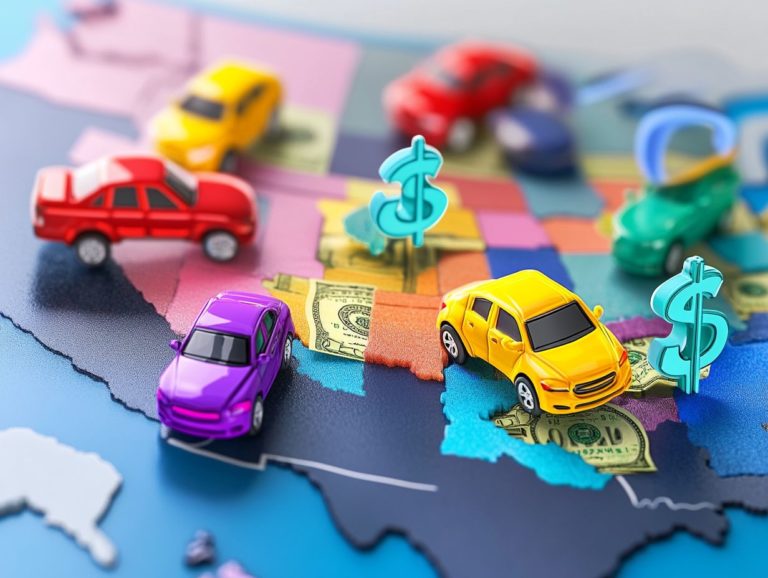7 Strategies for High-Risk Drivers to Save Money
Navigating car insurance can feel overwhelming, especially for high-risk drivers who often deal with elevated premiums. You ll also learn how insurance companies assess risk and dispel some common misconceptions that may be holding you back.
However, there are effective strategies to help reduce these costs. From diligently shopping around for the best rates to refining your driving habits, this article presents seven actionable tips crafted to save you money on car insurance. Read on to uncover simple tips that can help you lower your premiums today!
Contents
- Key Takeaways:
- 1. Shop Around for Car Insurance
- 2. Consider a Higher Deductible
- 3. Take Advantage of Discounts
- 4. Improve Your Driving Habits
- 5. Look Into Usage-Based Insurance
- 6. Consider Alternative Transportation Options
- 7. Take a Defensive Driving Course
- How Do Insurance Companies Determine High-Risk Drivers?
- What Factors Can Increase Insurance Rates for High-Risk Drivers?
- What Are the Different Types of High-Risk Drivers?
- How Can High-Risk Drivers Improve Their Insurance Rates?
- Consequences of Being a High-Risk Driver: What You Need to Know!
- How Can High-Risk Drivers Save Money in the Long Run?
- What Are the Common Myths About High-Risk Drivers and Car Insurance?
- Frequently Asked Questions
Key Takeaways:

- Shop around for car insurance to find the best rates for high-risk drivers.
- Consider a higher deductible to lower monthly premiums.
- Improve driving habits and take defensive driving courses to show insurance companies your responsibility and potentially lower rates.
1. Shop Around for Car Insurance
Shopping around for car insurance is crucial to finding the ideal auto insurance policy that meets your needs while keeping costs manageable. It s all about comparing premium rates from various insurance companies to secure the most advantageous quotes, leading to substantial savings.
By leveraging online resources like Bankrate and Coverage.com, you can quickly access a wide array of quotes from multiple insurers at once. These tools provide convenient side-by-side comparisons, making it easy to spot potential savings and discounts you might otherwise overlook.
This strategic approach allows you to customize coverage options tailored to your unique driving habits and lifestyle. This way, you’re not paying for unnecessary coverage while still being well-protected on the road.
2. Consider a Higher Deductible
Act now by considering a higher deductible to instantly lower your car insurance premium rates. This choice can save you money over time while still providing affordable coverage in the event of an accident.
By opting for a higher deductible, you ll likely notice a decrease in your monthly insurance payments, freeing up funds for other expenses or investments. For instance, if you choose a $1,000 deductible instead of a $500 one, you could save up to 20% on your annual premium rates.
This choice affects how much you pay when you file a claim and encourages you to be more mindful of how often you use your coverage. Striking this balance between risk and savings can lead to greater financial stability.
3. Take Advantage of Discounts
Taking advantage of various insurance discounts can significantly reduce your car insurance premium, making it easier to secure affordable coverage while rewarding your safe driving habits and loyalty to your insurance provider.
For example, many insurance companies offer a good student discount for young drivers who maintain a certain academic standard and a loyalty discount for those who stay with the same provider over the years. Bundling discounts also apply when you combine multiple types of insurance like auto and home leading to significant savings.
As you explore these opportunities, ask your insurance agents about discounts tailored to your profile. Additionally, understanding high-risk driver insurance options can help you navigate your choices. Demonstrating a solid track record of safe driving not only boosts your chances for lower rates but also showcases your commitment to responsible behavior on the road.
If you have experiences or questions, feel free to share them below!
4. Improve Your Driving Habits

Improving your driving habits enhances safety on the road. It can also boost your driving record, leading to car insurance discounts and better coverage options.
Enroll in defensive driving courses to sharpen your skills for various road conditions. You can also participate in telematics programs these track your driving through apps and give you insights to adjust your habits.
Such measures contribute to safer driving and a cleaner driving record. Over time, that can lead to lower premiums and access to more insurance options, giving you financial savings and peace of mind.
5. Look Into Usage-Based Insurance
Consider usage-based insurance, which uses telematics to monitor your driving. This could help lower your premium rates based on your actual driving habits instead of traditional assessments.
By collecting real-time data on how you accelerate, brake, and your overall speed, insurers gain insights into your safety. This technology allows for a personalized premium calculation, rewarding safe drivers with discounts.
If you’re a high-risk driver, a telematics program might inspire positive changes in your habits. This can lead to lower rates and safer roads for everyone.
6. Consider Alternative Transportation Options
Exploring alternative transportation options can reduce your reliance on car insurance. This shift allows for savings that can be redirected to other essential expenses.
Using public transit can save you money on fuel, parking fees, and vehicle maintenance. Carpooling or ridesharing can further reduce everyday costs and enhance community connections.
Transitioning away from car ownership can also lead to significant changes in your insurance. With less driving, your premiums could drop considerably.
7. Take a Defensive Driving Course
Enroll in a defensive driving course to become a safer driver. This can also lead to valuable discounts on your car insurance.
These courses teach crucial strategies for handling various driving situations, significantly reducing accidents. You’ll learn how to anticipate hazards and maintain a safer following distance.
Reputable organizations like the National Safety Council and AAA offer classes online and in-person. Completing one cultivates a responsible mindset and may lead to reduced premiums, as many insurers reward these safe practices.
How Do Insurance Companies Determine High-Risk Drivers?

Insurance companies evaluate multiple factors to identify high-risk drivers. These include your driving record, accident frequency, and other metrics that influence premium rates. These assessments ultimately shape your financial decisions regarding car insurance coverage.
Variables such as your age, driving experience, and the type of vehicle you own are pivotal in this evaluation. A history of multiple violations like speeding tickets or DUI offenses can classify you as more likely to file a claim, leading to higher premiums. This classification may limit your access to affordable coverage options.
High-risk drivers can manage their insurance costs effectively. Seek out companies that specialize in high-risk policies, enroll in defensive driving courses (which teach safe driving techniques), and maintain a clean record over time. Additionally, consider following these tips for staying safe as a high-risk driver. These steps can gradually improve your status and open up more favorable insurance opportunities.
What Factors Can Increase Insurance Rates for High-Risk Drivers?
Several factors can drive up insurance rates for high-risk drivers, such as a poor driving record, multiple accidents, and a claims history. Insurers carefully scrutinize these to set premium rates.
These elements not only reflect your driving behavior but also serve as crucial indicators that insurance companies analyze to estimate the likelihood of future claims. Repeated traffic violations like speeding tickets or driving under the influence significantly influence your risk profile. A track record of at-fault accidents establishes a concerning pattern of risky behavior that insurers take seriously.
If you re classified as a high-risk driver and want to improve your status, take proactive steps:
- Complete defensive driving courses
- Maintain a clean driving record
- Shop around for better rates
By addressing these issues, you can lessen your financial burden and potentially lower your premiums!
What Are the Different Types of High-Risk Drivers?
You ll encounter various types of high-risk drivers, including those with poor driving records, DUI offenders, and young drivers with limited experience. Each group faces its own challenges when it comes to car insurance and liability coverage (insurance that protects you if you’re responsible for an accident).
Individuals with a history of accidents or traffic violations often find it difficult to secure affordable premiums. Insurers view their past behavior as a red flag for potential future risks. Similarly, DUI offenders grapple with higher rates and stricter policy terms that reflect the serious implications of their choices behind the wheel.
Young drivers, despite their eagerness to learn, face a challenging position due to their lack of driving experience, resulting in elevated costs and fewer options. Understanding how to navigate the insurance market as a high-risk driver is crucial, as each category of high-risk driver presents distinct obstacles that significantly impact both liability coverage and the premiums they encounter.
How Can High-Risk Drivers Improve Their Insurance Rates?
High-risk drivers can enhance their insurance rates by embracing safe driving practices, enrolling in defensive driving courses, and regularly reviewing their driving records for accuracy and potential discounts. Additionally, exploring strategies for managing insurance costs can provide valuable insights for better rates.
It’s crucial to maintain a clean driving record by avoiding traffic violations and accidents. Even minor infractions can lead to significant rate increases. Utilize available resources, such as driver improvement programs, and seek out the best low-cost insurance policies for high-risk drivers that offer incentives for good driving behavior to further lower your premiums.
Stay informed about changes in insurance laws and regulations to make more informed decisions. Establish safe driving habits like limiting distractions and adhering to speed limits to enhance safety on the road and contribute to a more favorable insurance profile over time.
Start applying these tips today to enhance your driving record and lower your insurance costs!
Consequences of Being a High-Risk Driver: What You Need to Know!

Being labeled as a high-risk driver can bring significant repercussions, including elevated premium rates and limited insurance options. This classification makes it harder to find affordable coverage.
You may also need to rethink your overall financial health. Many people find themselves allocating a larger portion of their budget to insurance, which can take away money from savings or other vital expenses.
This financial burden can add up over time. It can potentially impact your credit score, making it more challenging to find reasonably priced insurance in the future.
Recognizing the broader implications is essential. The mounting costs and stress can impede your ability to make sound financial choices, trapping you in a cycle of hardship that can be challenging to break free from.
How Can High-Risk Drivers Save Money in the Long Run?
High-risk drivers have a valuable opportunity to save money in the long run by embracing safe driving practices, capitalizing on insurance discounts, and consistently shopping around for better car insurance rates. Following 7 tips to find affordable insurance can help ensure their rates reflect their improved driving behavior.
Implementing strategies such as taking defensive driving courses, maintaining a clean driving record, and adhering to speed limits can reshape how insurers perceive you, helping you understand how to lower your premiums as a high-risk driver.
Many insurance companies love to reward safe drivers with great discounts! Regularly reviewing your insurance policies can also reveal additional savings opportunities.
As your driving habits evolve and your risk profile improves, you may reap significant financial benefits. This creates a cycle of positive reinforcement that fuels your motivation to make safer driving choices.
What Are the Common Myths About High-Risk Drivers and Car Insurance?
Common myths surrounding high-risk drivers and car insurance can lead to misunderstandings about premium rates, coverage options, and the factors that shape insurance companies’ assessments.
These misconceptions can add unnecessary stress to your life if you’re labeled as a high-risk driver. You may feel like your only choices are sky-high premiums or limited coverage.
In truth, being categorized as high-risk hinges on several criteria, including your driving history, the type of vehicle you drive, and even your geographic location. Not all insurance providers view high-risk profiles the same way; many offer competitive rates that you might be overlooking.
By clearing up these misunderstandings, you empower yourself to seek out viable, cost-effective solutions tailored to your unique driving situation.
Frequently Asked Questions
What are some strategies for high-risk drivers to save money?
- Take a defensive driving course to improve your skills and potentially reduce your insurance premiums.
- Shop around for car insurance and compare rates from different providers to find the best deal.
- Consider increasing your deductible to lower your monthly premiums, but ensure you have enough savings to cover it in case of an accident.
- Install safety devices in your car, such as a dash cam or anti-theft system, to potentially receive discounts on your insurance.
- Maintain a good credit score, as this can impact your insurance rates. Pay bills on time and keep credit card balances low to improve your score.
- Avoid getting traffic violations or accidents, as these can significantly increase your insurance rates.
- Consider downgrading to a cheaper car or opting for a higher mileage plan if you don’t drive frequently to save on car insurance costs.





